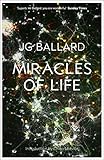
- 作者: J. G. Ballard,China Mieville
- 出版社/メーカー: Fourth Estate Ltd
- 発売日: 2008/11/01
- メディア: ペーパーバック
- 購入: 1人 クリック: 7回
- この商品を含むブログ (12件) を見る
さて、バラードの自伝Miracles of Life*2を命日の前後に読了。
第一部が上海(子ども)篇、第二部が英国(大人)篇となっている。
Part I
Shanghai Arrival (1930)
Japanese Invasion (1937)
War in Europe (1939)
My Parents
The Attack on Pearl Harbor (1941)
Lunghua Camp (1943)
Chess, Boredom and a Certain Estrangement (1943)
American Air Raids (1944)
The Railway Station (1945)
War’s End (1945)
Part II
Take it on the Chin (1946)
Cambridge Blues (1949)
Screaming Popes (1951)
Vital Discoveries (1953)
Miracles of Life (1955)
This is Tomorrow (1956)
Wise Women (1964)
The Atrocity Exhibition (1966)
Healing Times (1967)
New Sculpture (1969)
Lunches and Films (1987)
Return to Shanghai (1991)
Homeward Bound (2007)
バラードの上海の記憶で重要なのは〈死体〉であろう。例えば、
(…) Every morning when I was driven to school I would notice fresh coffins left by the roadside, sometimes miniature coffins decked with paper flowers containing children of my own age. Bodies lay in the streets of downtown Shanghai, wept over by Chinese peasant women, ignored in the rush of passer-by. Once, when my father took me to his office in the Szechuan Road, near the Bund, a Chinese family had spent the night huddling against the steel grille at the top of the entrance steps. They had been driven away by the security guards., leaving a dead baby against the grille, its life ended by disease or the fierce cold. In the Bubbling Well Road our car had to halt when the rickshaw coolie in front of us suddenly stopped, lowered his cotton trousers and leant forward over his shafts, defecating a torrent of yellow liquid at the roadside, to stepped in by the passing crowds and carried all over Shanghai, bearing dysentery or cholera into every factory, shop and office. (pp.14-15)
また、バラードは終戦直後に日本兵による中国人虐殺の一部始終を目撃している(pp.105-107)。バラードは剣橋で医学(解剖学)を専攻するが、その動機について、
The most visible features of the flat landscape beyond Amherst Avenue were the family burial mounds built onto the retaining walls of the paddy fields. The water table was only three feet below the surface of the ground, and none of the villagers buried their dead beneath the soil (at one time I went through a well-digging phase, sinking half a dozen wells into the flowerbeds in our garden until the gardener protested). The mounds could be six to ten feet high, a pyramid of coffins covered with soil that the heavy rains would wash away. Unless regularly maintained, the coffins would emerge into the daylight.
There was a burial mound on the edge of an abandoned paddy field three hundred yards from our house. One day, on my way back from school, I made a small detour to the mound, climbed up the rotting pyramid and peered into one of the lidless coffins. The skeleton of a forgotten rice farmer lay on what seemed like a mattress of silk – the soil around him had been endlessly washed and rinsed by the rains. Years later, as a Cambridge medical student, I would sleep in my college room with my anatomy skeleton in a coffin-like pine box under my bed. I was told that the skeleton’s modest height did not mean it was that of a child – most anatomy skeletons were those of south-east Asian Peasants. (pp.32-33)
と書いている*3。また、
I was well aware that my reasons for studying medicine were strongly influenced by memories of wartime Shanghai, and by the horrors of the European war exposed at the Nuremberg trials. The dead Chinese I had seen as a boy still lay in their ditches within my mind, an ugly mystery that needed to be solved. (pp.136-137)
さて、第15章の”Miracles of Life (1955)”は本の題名と同じになっている。これはMary Matthewsとの(できちゃった)結婚;
(…) In many ways my entire fiction is the dissection of a deep pathology that I had witnessed in Shanghai and later in the post-war world, from the threat of nuclear war to the assassination of President Kennedy, from the death of my wife to the violence that underpinned the entertainment culture of the last decades of the century. Or it may be that my two years in the dissecting room were an unconscious way of keeping Shanghai alive by other means. (p.145)
さらに” Wise Women (1964)”では、”Perhaps I belong to the first generation for whom the health and happiness of their families is a significant indicator of their own mental well-being.”と書かれている(p.199)。また、”I enjoyed being married, the first real security I had ever known(…)”とも(ibid.)。この次の頁には” the first real security”の呆気ない崩壊、妻Maryの急死のことが書かれているのだが。
(…)My life had been witness to wars and destruction, to erosion and entropy, capped by two years in the dissecting room at Cambridge, paring down the cadavers as if death itself was not final enough, and the remains of these human beings needed to be further diminished. Now, for the first time, I had helped to create something, almost out of nothing, an intact and growing creature that would emerge as a living being. Mary was three months pregnant when we married, and I would lie beside her, touching the swelling of her womb, willing on this little visitor from beyond time and space. Creation on the grandest scale was taking place under the warmth of my hand. (p.180)
この他にも、現代アートへのコメント、SFとの出会い、自作へのコメント等々、興味深い内容が満載なのだが、それについてはまた後日。
*1:http://d.hatena.ne.jp/sumita-m/20090528/1243469093 バラードについては、http://d.hatena.ne.jp/sumita-m/20060916/1158392738 http://d.hatena.ne.jp/sumita-m/20061230/1167457457 http://d.hatena.ne.jp/sumita-m/20090604/1244084935 http://d.hatena.ne.jp/sumita-m/20090615/1245033980も参照のこと。
*2:See http://d.hatena.ne.jp/sumita-m/20091007/1254889447 Cited in http://d.hatena.ne.jp/sumita-m/20100313/1268466640 http://d.hatena.ne.jp/sumita-m/20100418/1271571481
*3:See also p.142